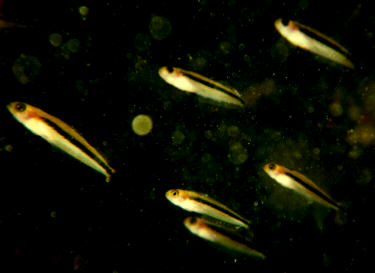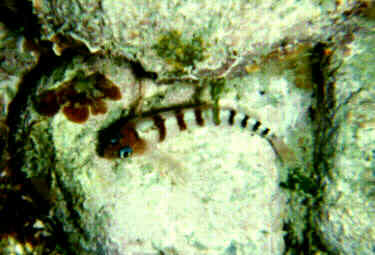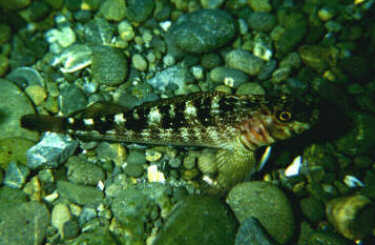
Oblique-swimming Blue-eyed Common Variable Long-finned
The Triplefin family are small, carnivorous, and mainly bottom living fish which have three dorsal fins. They are usually seen perched on their pectoral and pelvic fins. When they swim they move in short hops. There are at least thirty species in New Zealand.

(Obliquichthys maryannae)
Habitat: Usually seen swimming up to 5 m above reefs.
Identification: Coloured yellow-orange with black-stripe and black eyes. They form schools of several, to several thousand, all swimming at an oblique angle. Length to 8 cm.
General: These fish are the only triplefins known to form schools. They eat mainly small plankton which they catch while facing into the current, and may eat small bottom-living crustaceans.
Rex's sightings: Around the Yung Pen at Owhiro Bay, Elsdon Point Pipe. Pretty general, really.

(Notoclinops segmentatus)
Habitat: Reefs, particularly on steep slopes or under overhangs.
Identification: Head yellow-orange; body silver with 9 red bands; eyes iridescent blue. Length 6 cm.
General: They eat small crustaceans, but have also been seen cleaning parasites from
large fish such as moray eels.
(Fosterygion sp.)
Habitat: Reefs, particularly areas of cobbles, boulders or rock flats. Most common in water shallower than 5 m.
Identification: Basic body colour varies from white, through grey-brown, to black. A black stripe along the side, second and third fins usually red. Black fish are probably spawning males.
General: Eggs laid on smooth rock, particularly on the underside of cobblestones, and they hatch in about 20 days. They may act as cleanerfish, removing parasites from larger fish.

(Fosterygion varium)
Habitat: Reefs, particularly broken rock areas with some kelp cover. Most abundant shallower than 10 m.
Identification: Brown-black blotches along middle of body, separated by cream white spots on back; eye yellow. Length to 20 cm.
General: They eat small crustaceans, crabs, hermit crabs and shellfish. Eggs laid on smooth, sloping rock faces, and are guarded by males. Males grow faster and bigger than females.
(Ruanoho decemdigitatus)
Habitat: Reefs, usually near shelter of boulders or crevices. Rarely deeper than 10 m.
Identification: Females grey, mottled with dark brown, black and cream-yellow. Males black, apart from white pelvic fins.
General: They lay their eggs on the underside of flat stones. Commonly taken by hand in low-tidal rock pools.
Rex's sightings: In the cracks in the wall beneath Burnham Wharf.